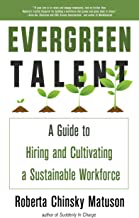By William Carmichael
The number of workforce recruitment and retention books available today is infinite it seems. So much so that selecting one that can benefit your organization is difficult if not downright impossible. And if the author is unfamiliar to you, questions arise as to that author’s background, experience, and credentials. This was my conundrum with Evergreen Talent: A Guide to Hiring and Cultivating a Sustainable Workforce by Roberta Chinsky Matuson. Although I consider myself well read, I honestly was unfamiliar with the author. The book cover’s attractive design and message caught my eye though. And despite the overdone seed/tree/forest comparation, I couldn’t be more pleased with the author’s applicable message and helpful advice to HR professionals regarding “Talent Cultivation!” Clearly this author knows what she is talking about.
Question- Why is Finding Qualified Talent So Hard?
In Evergreen Talent’s Introduction, the author poses a question. “How is it that some companies appear to effortlessly hire and retain people, while other companies seem to be in a constant state of hiring because they can’t fill positions or their people leave so soon after they arrived?” As a former HR Director, that is a question I had asked from time to time. And not because of the effort I expended on finding that person. That was my job, right? But as the one responsible for also getting that person trained properly, something appeared out of balance. Here, the return on investment became upside down. Where did things go wrong? I see now it was the questions I failed to ask and this is where Matuson becomes so valuable to us as a seasoned, knowledgeable HR coach.
With a vast amount of HR management and consulting experience, Matuson probes us with some very effective questions:
| Question | Standard HR Response | Matuson’s Response |
| “Everyone in our industry is having a difficult time finding and keeping people.” | “Agreed, all our competitors are experiencing the same thing.” | “I can assure you, someone in your industry has the lion’s share of talent. That someone might not be you—just yet.” |
| “It’s the job of HR to hire and develop people.” | “Yes, my HR team can train them better than anyone.” | “Actually, it’s the job of the hiring manager to recruit and develop team members.” |
| “People are lucky to have a job with us.” | “This is exactly what we allude to in the interview.” | “That may have been true during the recession. However, current record levels of low employment render this argument inaccurate.” |
It is not just these types of inquiries that make Evergreen Talent worthy of our attention but rather the directly relatable questions she asks at the end of each chapter. To be completely honest, some will catch you off guard but in a very good way. For example, the questions asked in how we should apply the knowledge learned in Chapter 2’s Surveying the Terrain, which deals with the search for qualified talent. Forget for a moment how committed you are to finding the right person; the real question is how committed is your organization to finding that person? How will you implement the search? What will be your methodology? Tough, but necessary questions that will cause you to think differently about the solutions needed.
Why this is a Must Read
This excellent HR field guide provides a structure for understanding organizational culture in a practical way. It breaks down what leaders need to do to not only create the appropriate culture but to also hire, nurture and grow people who will be successful in that culture. What is unique about this book is that it goes beyond the “obvious fits” and provides roadmaps for uncovering talent and potential brilliance that is already there. Perhaps most importantly, Matuson challenges leaders to think differently about their approach to growing a sustainable workforce.
Structure and Layout
Most readers will find Evergreen Talent: A Guide to Hiring and Cultivating a Sustainable Workforce to be a quick, enjoyable read. Its twelve chapters are designed to take HR practitioners through the four distinctive stages needed for sustaining talent growth. Part I- Preparing Your Organization does an excellent job of; debunking HR myths that tend to get in our way, identifying elements needed for talent recruitment, and how to prepare your organization for new approaches. Part II- Seeding Your Organization reviews; identifying talent, sustainable hiring practices, and how to reinvigorate dormant workers. Part III- Cultivating Your Workforce discusses; how to identify when its time to make workforce changes, the necessity of training, and why effectively working with mature workers is so vital for your organizations’ survival. Part IV- Creating and Sustaining Growth does a remarkable job of describing how to manage it all.
Mentioned earlier, questions the author poses at the end of each chapter carry with them not only a unique sense of urgency that Matuson brings to the table but the significance of those questions to the survival of the organization. They allow the reader to approach the recruitment and retention process from a different leadership perspective. The book is filled with pragmatic advice, case studies, and best practices from companies that have done this successfully. Also included are tools to help readers assess their workplace environment and populate their organization with talent that will continue to grow, year after year.
About the authors:
Roberta Chinsky Matuson is the CEO of Matuson Consulting, a top management consulting firm established 20 years ago, which has helped organizations of all kinds- including GM Microsoft, and Best Buy- achieve dramatic growth and market leadership through maximizing talent. Matuson was named one of 2018 LinkedIn Top Voices for Management & Workplace. She is quoted regularly in media such as the Wall Street Journal, Working Woman, MSNBC.com, NPR, Fox Business News, and CNN. She blogs for Fast Company, Forbes, and Thrive Global and speaks regularly to large professional and lay audiences, and has eight courses with Lynda/LinkedIn.

Ed.D Professor | Strayer University william.carmichael@strayer.edu www.strayer.edu
